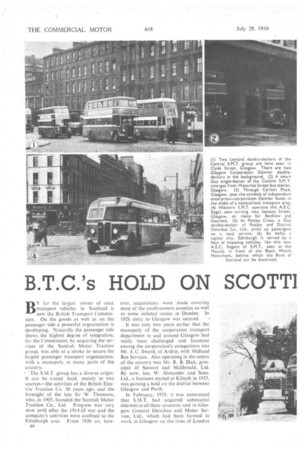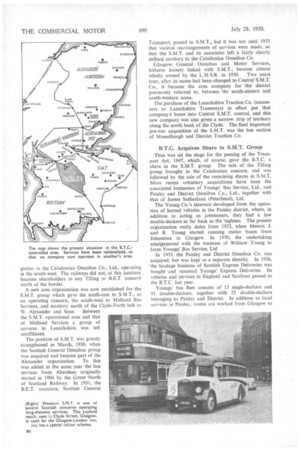B.T.C.'s HOLD ON SCOTT]
Page 38

Page 39

Page 40

Page 43

If you've noticed an error in this article please click here to report it so we can fix it.
El PASSENGER TRANSPORT
By C. S. DU N BAR, minst.T.
BY far the largest owner of road transport vehicles in Scotland is now the British Transport Commission. On the goods as well as on the passenger side a powerful organization is developing. Naturally the passenger side shows the highest degree of integration, for the Commission, by acquiring the services of the Scottish Motor Traction group, was able at a stroke to secure the largest passenger transport organization, with a monopoly in many parts of the country.
The S.M.T. group has a diverse origin. It can be traced back mainly to two sources—the activities of the British Electric Traction Co. 50 years ago, and the foresight of the late Sir W. Thomson, who, in 1905, founded the Scottish Motor Traction Co., Ltd. Progress was very slow until after the 1914-18 war and the company's activities were confined to the Edinburgh area. From 1920 on, how
a4 ever, acquisitions were made covering most of the south-eastern counties as well as some isolated routes in Dundee. In 1926 entry to Glasgow was secured.
It was only two years earlier that the monopoly of the corporation transport department in and around Glasgow had really been challenged and foremost among the corporation's competitors was Mr. J. C. Sword, of Ardrie, with Midland Bus Services. Also operating in the centre of the country was Mr. R. B. Dick, principal of Stewart and McDonald, Ltd. By now, too, W. Alexander and Sons. Ltd., a business started at Kilsyth in 1923. was gaining a hold on the district between Glasgow and Perth.
In February, 1929, it was announced that S.M.T. had acquired substantial interests in all these concerns and in Glasgow General Omnibus and Motor Service, Ltd., which had been formed to work in Glasgow on the lines of London Passenger Transport Board. Five months later, in July. the L.M.S.R. and L.N.E.R. became shareholders in a new company formed to take over the S.M.T. interests.
Meanwhile the BET. group was expanding. At the beginning of the century the trams at Greenock, Rothesay. Airdrie and Coatbridge were acquired and electrified. Other privately owned tramways in Scotland included the independent Lanarkshire system, the Balfour-Beatty group (Dumbarton, Falkirk, Dunfermline, Wemyss and Broughty Ferry), the Musselburgh and District Traction Co. (associated with the National Electric Construction Co., Ltd.) and the Paisley system of the British Thomson-Houston Co.
The Airdrie, Coatbridge .and Paisley trams still survive as part of the Glasgow Corporation system and the Musselburgh lines as part of the Edinburgh undertaking: all the others have disappeared.
Motorbuses were introduced to feed the Airdrie-Coatbridge system in 1911, and in 1913 the B.E.T. formed the Scottish General Transport Co., Ltd., to run buses in connection with all its tramway interests in Scotland. In the same year the Lanarkshire Traction Co., which had earlier experimented unsuccessfully with buses, resumed the operation of motor vehicles.
The Balfour-Beatty group also started
bus services at Falkirk in 1913, and at the close of the first world war followed the example of B.E.T. by setting up the Scottish General Omnibus Co., Ltd., to run buses for all its Scottish tramway companies.
It will now be seen that, at the time of the agreement between the railways, the , Tilling group and the B.E.T. in 1929, the last-named had a substantial interest in bus and tram operation in Scotland. The Tilling interest was confined to partici pation in the Caledonian Omnibus Co., Ltd., operating in the south-west. The railways did not, at this juncture become shareholders in any Tilling or B.E.T. concern north of the border.
A new area organization was now established for the S.M.T. group which gave the south-east to S.M.T., as an operating concern, the south-west to Midland Bus Services, and territory north of the Clyde-Forth -belt to W. Alexander and Sons. Between the S.M.T. operational area and that of Midland Services a group of services in Lanarkshire was left unaffiliated.
The position of S.M T. was greatly strengthened in March, 1930, when the Scottish General Omnibus group was acquired and became part of the Alexander organization. To this was added in the same year the bus services from Aberdeen originally started in 1904 by the Great North of Scotland Railway. In 1931, the B.E.T. associate, Scottish General Transport, passed to S.M T., but it was not until 1933. that various rearrangements of services were made, so that the S.M.T. and its associates left a fairly clearly defined territory to the Caledonian Omnibus Co.
Glasgow General Omnibus and Motor Services, hitherto loosely linked with S.M.T., became almost wholly owned by the L.M S.R. in 1930. Two years later, after its name had been changed to Central S.M.T. Co., it became the area company for the district previously referred to, between the south-eastern arid south-western areas.
The purchase of the Lanarkshire Traction Co. (successors to Lanarkshire Tramways) in effect put that company s buses into Central S.M.T. control, and this new company was also given a narrow strip of territory along the north bank of the Clyde. The final important pre-war acquisition of the S.M.T. was the bus section of Musselburgh and District Traction Co.
B.T.C. Acquires Share in S.M.T. Group
Thus was set the stage for the passing of the Transport Act, 1947, which, of course, gave the B.T.C. a share in the S.M.T. group. The sale of the Tilling group brought in the Caledonian concern, and was followed by the sale of the remaining shares in S.M.T. More recent voluntary acquisitions have been the associated businesses of Youngs' Bus Service, Ltd., and Paisley and District Omnibus Co., Ltd., together with that of James Sutherland (Peterhead), Ltd.
The Young Co.'s interests developed from the operation of horsed vehicles in the Paisley district, where, in addition to acting as jobmasters, they had a few double-deckers as far back as the 'eighties. The present organization really dates from 1925, when Messrs. J. and R. Young started running motor buses from Johnstone to Glasgow. In 1930, the undertaking amalgamated with the business of William Young to form Youngs' Bus Service, Ltd In 1933, the Paisley and District Omnibus Co. was acquired, but was kept as a separate identity. In 1936, the haulage business of Scottish Express Deliveries was bought and renamed Youngs' Express Deliveries. Its vehicles and services in England and Scotland passed to the B.T.C. last year.
Youngs' bus fleet consists of 15 single-deckers and 91 double-deckers, together with 25 double-deckers belonging to Paisley and District. In addition to local services in Paisley, routes are worked from Glasgow to Johnstonç and on to Lams and other places on the Ayrshire coast. There is a large depot and maintenance works,'covering 2facres, at Johnstone.
A slight difficulty occurred after the take-over because of the S.M.T. Co.'s holdings in businesses not connected with bus operation. The B.T.C. is not acquiring these
• oufside interests, and unlit the parent company is wound up the name Scottish Motor Traction Co. cannot, of course, be used for the bus businesses under B.T.C. control. These are, therefore, being run meantime under the name of Scottish Omnibuses, Ltd.
The Caledonian Omnibus Co. has been wound up and its services have passed to Western S.M.T., except those from Edinburgh to Dumfries, which are being worked by Scottish Omnibuses. James Sutherland has been incorporated in Alexander's Northern Area, as have also the isolated S.M.T. routes radiating from Dundee. The map shows the present situation. The B.T.C., as successor to the railways, has a financial interest in David McBrayne, Ltd., which operates steamer services to the Western
Isles and bus services in the region of the Caledonian Canal and down to Kintyre, and in the Highland Transport Co., which serves the east coast north of InvernesS. These ebnipanies are not wholly owned and ape therefore outside, • the control of the Scottish Omnibuses group board, which operates on behalf of the Road Passenger Executive.
Mr. James Amos is chairman of the group board and the other' directors are the generalmanagers of the four companies: Mr. R. Beveridge (Scottish Omnibuses), Mr. R. B.
Dick, Junr. (Central S.M.T.), Mr. 1. C. Sword (Western S.M.T.), and Mr. W. Alexander, Junr. (W. Alexander and Sons)—plus Mr. W. Alexander, Senr., Mr. R. B. Dick, Sent., Mr. R. H. Wilson (comptroller, B.T.C.), Mr. T. F. Cameron (chief regional officer, Scottish Region, BR.), and Mr. T. H. Moffatt (deputy chief regional officer, Scottish Region, BR.).
The Scottish Omnibuses group is unusual among big bus undertakings in Great Britain in having practically no pooling arrangements with other operators. In fact, the only ones of which I have knowledge are the agreement: with Ribble and United Automobile Services in respect of the long-distance cross-border services..
There are, however, four corporations which are entitled to a share of the profits on local services in their burghs on account of former tram services taken over by the group. These are the corporations of Perth, Kirkcaldy, Ayr and Kilmarnock. The four remaining municipal undertakings (those of Glasgow, Edinburgh, Dundee. and Aberdeen) have no pooling arrangements with other operators.
Vehicles in the group at February 21, 1950, totalled 3,865. Scottish Omnibuses, Ltd., had 562 single-deckers and 167 double-deckers, making a total of 729 vehicles. Central S.M.T. had a total of 591 vehicles, comprised of 156 single-deckers and 435 , double-deckers, whilst
Western S.KT., with a total of 890 vehicles, had 363 single-deck3rs and 527 double-deckers The Alexander group had a total of 1,655 vehicles, 1,124 being singledeckers and 531 double-deckers. Altogether there were 2,205 single-deckers and 1,660 double-deckers.
In the near future I shall describe the work of the B.T.C. in the Scottish haulage field, where a far more complex situation exists, because of geographical as well as commercial factors.












































































